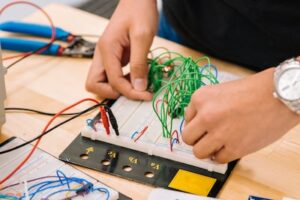
How can flexible learning help you expand your knowledge?
Flexibility, oh how we crave it in this chaotic world! Well, fear not, for flexible learning benefits are here to save the day! Picture this: you, in your pajamas, sipping coffee while simultaneously absorbing knowledge like a sponge (a very caffeinated sponge, mind you). Yes, with flexible learning, we can expand our knowledge at our own erratic pace, whether we’re a night owl or an early bird, a multitasker or a procrastinator extraordinnaire.
No more rigid schedules or awkward classrooms; just you, your laptop, and the weird comfort of knowing that you can take breaks whenever you darn well please. So, come join the flexible learning revolution and discover a whole new world of random bursts of information and the occasional joyous revelation! It’s time to embrace the wacky, wonderful, and wibbly-wobbly world of flexible learning benefits.
Table of Contents
Flexibility: Learn in your pajamas (or even your birthday suit!)
Embrace your inner student with flexible learning on your own terms. Whether at home, during your commute, or on a tropical beach, you can now enjoy learning without the confines of boring classrooms or stuffy lecture halls. Unlock your true potential and indulge in the wonders of flexible learning.
articly.ai tagvoicedrop.ai tag
Explore the Expansive World of Technology with TopTechCourses!
Looking to expand your knowledge in the ever-evolving world of technology? Look no further than TopTechCourses! With over 10,000 courses in Spanish, this online marketplace offers a smorgasbord of wacky and wonderful tech and programming classes. Whether you want to dabble in web development, unravel the mysteries of data science, or even unleash your inner AI genius, they’ve got you covered.
Taught by real-life tech wizards, these courses cater to all skill levels, ensuring everyone can join the geeky fun. Plus, yep, you guessed it, you get a fancy certificate upon completion.
So why wait? Join the TopTechCourses revolution and catapult your tech career into the stratosphere!
Frequently Asked Questions
Flexible learning refers to a mode of education that allows students to have control over the time, place, and pace of their learning. It provides them with flexibility in choosing their study schedule, resources, and learning environment.
Flexible learning allows individuals to tailor their learning experience according to their preferences and needs. They can choose different learning methods, access a variety of resources, and explore topics at their own pace. This freedom to customize the learning process enables students to delve deeper into areas of interest, broaden their understanding, and expand their knowledge beyond traditional classroom boundaries.
Flexible learning offers numerous advantages, such as personalized learning experiences, increased engagement, and improved time management. It allows individuals to learn at their own speed, making it easier for them to grasp complex concepts. Moreover, flexible learning also promotes self-discipline, independent thinking, and problem-solving skills, which are valuable for lifelong learning and personal growth.
Flexible learning is beneficial for a wide range of individuals, including working professionals, parents, individuals with disabilities, and those living in remote areas. It allows them to balance their personal and professional commitments while pursuing education. Additionally, people who prefer non-traditional learning environments or have specific learning styles can also benefit greatly from flexible learning.
Various technologies support flexible learning, including online platforms, video conferencing tools, learning management systems, virtual reality, and mobile apps. These technologies enable individuals to access educational resources, collaborate with peers, and receive guidance from instructors anytime and anywhere, making the learning process more convenient and accessible.
Flexible learning provides an alternative to traditional classroom education but cannot completely replace it. While flexible learning offers numerous benefits and fits well with the needs of many learners, there are still certain aspects of traditional classroom education, like face-to-face interaction and hands-on practical experiences, that cannot be entirely replicated in a flexible learning environment. A combination of both approaches can often provide a comprehensive educational experience.
Summary
Are you tired of the traditional classroom setting? Bored out of your mind, listening to droning professors and taking notes until your hand cramps up? Well, my friend, it’s time to say goodbye to the mundane and embrace flexible learning! With flexible learning, you have the freedom to expand your knowledge in the quirkiest and most unexpected ways. Picture this: you can attend virtual classes in your pajamas, while sipping on a cup of hot chocolate, and even petting your cat.
Who needs a rigid timetable when you can create your own? Plus, you can explore fascinating subjects like ‘The Art of Monkey Mime’ or ‘The History of Comic Sans’ – because why not? So, wave goodbye to those archaic textbooks and let’s embark on an erratic and whimsical journey of learning! Trust me, your brain cells will thank you for it.





